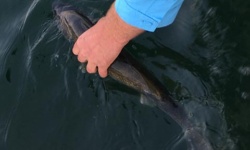Spring migration is full of hope.
There are the regular spring birds to anticipate, like rose-breasted grosbeaks, Baltimore orioles, and ruby-throated hummingbirds. Yet there is also a chance you might see a new species of warbler or get that killer look at a golden-winged warbler you’ve always dreamed of seeing right in your favorite birding patch.
We are in a holding pattern in the Upper Midwest as we expect a few teaser days of upper-40 degrees – and then blammo: six inches of snow or a week-long stretch of temperatures well below freezing. Area lakes are opening slowly, so we aren’t seeing the waterfowl action we expected.
But eventually, spring will come. Some birds are insisting on its arrival, like the great blue herons already incubating eggs on rookeries. In the meantime we can establish our game plans.
First, check your bird radar for night migration. I’ve always admired the great University of Wisconsin-Madison’s Nexrad radar for bird migration. On nights with heavy bird movement, it picks up millions of birds via the radar, and they resemble blue circles, unlike the red/yellow/green swirls of precipitation. On nights with lots of blue circles, I visit my roof and listen for the little chirps that birds give to each other to maintain contact on their long journey. Other friends I know use it as an opportunity to use some sick leave for daytime birding.
The past few years, a group of researchers with Cornell Lab of Ornithology has been working on a project called BirdCast. Each week during migration, the group tries to predict when the big movements and fall-outs will hit, so you can plan your time off from work. They consider time of year and weather.
This year they have really upped their game: BirdCast is using migration and weather models from the past 23 years in Nexrad to predict how migration will play out based on weather patterns this season. They hope to have 24-, 48-, and 72-hour forecasts. Real-time maps will also track the intensity of bird migration, and we will now have access to more bird movement information than ever. We live in an age of miracles.
It should be a fun resource to check out as songbirds head north during the next few months. You should follow BirdCast to see if their predictions match the birds appearing in your yard.






